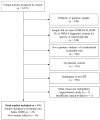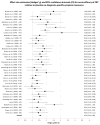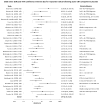Cognitive behavioral therapy for anxiety and related disorders: A meta-analysis of randomized placebo-controlled trials
- PMID: 29451967
- PMCID: PMC5992015
- DOI: 10.1002/da.22728
Cognitive behavioral therapy for anxiety and related disorders: A meta-analysis of randomized placebo-controlled trials
Abstract
The purpose of this study was to examine the efficacy of cognitive behavioral therapy (CBT) for anxiety-related disorders based on randomized placebo-controlled trials. We included 41 studies that randomly assigned patients (N = 2,843) with acute stress disorder, generalized anxiety disorder (GAD), obsessive compulsive disorder (OCD), panic disorder (PD), posttraumatic stress disorder (PTSD), or social anxiety disorder (SAD) to CBT or a psychological or pill placebo condition. Findings demonstrated moderate placebo-controlled effects of CBT on target disorder symptoms (Hedges' g = 0.56), and small to moderate effects on other anxiety symptoms (Hedges' g = 0.38), depression (Hedges' g = 0.31), and quality of life (Hedges' g = 0.30). Response rates in CBT compared to placebo were associated with an odds ratio of 2.97. Effects on the target disorder were significantly stronger for completer samples than intent-to-treat samples, and for individuals compared to group CBT in SAD and PTSD studies. Large effect sizes were found for OCD, GAD, and acute stress disorder, and small to moderate effect sizes were found for PTSD, SAD, and PD. In PTSD studies, dropout rates were greater in CBT (29.0%) compared to placebo (17.2%), but no difference in dropout was found across other disorders. Interventions primarily using exposure strategies had larger effect sizes than those using cognitive or cognitive and behavioral techniques, though this difference did not reach significance. Findings demonstrate that CBT is a moderately efficacious treatment for anxiety disorders when compared to placebo. More effective treatments are especially needed for PTSD, SAD, and PD.
Keywords: anxiety; anxiety disorders; behavior therapy; cognitive therapy; meta-analysis; treatment outcome.
© 2018 Wiley Periodicals, Inc.
Figures





References
-
- Bakhshani NM, Lashkaripour K, Sadjadi SA. Effectiveness of short term cognitive behavior therapy in patients with generalized anxiety disorder. Journal of Medical Sciences. 2007;7:1076–1081.
-
- Bakker A, van Dyck R, Spinhoven P, van Balkom AJ. Paroxetine, clomipramine, and cognitive therapy in the treatment of panic disorder. The Journal of Clinical Psychiatry. 1999;60:831–838. - PubMed
-
- Bandelow B, Reitt M, Röver C, Michaelis S, Görlich Y, Wedekind D. Efficacy of treatments for anxiety disorders: A meta-analysis. International Clinical Psychopharmacology. 2015;30:183–192. - PubMed
-
- Barlow DH, Gorman JM, Shear MK, Woods SW. Cognitive-behavioral therapy, imipramine, or their combination for panic disorder: A randomized controlled trial. JAMA. 2000;283:2529–2536. - PubMed
-
- Barlow DH, Sauer-Zavala S, Carl JR, Bullis JR, Ellard KK. The nature, diagnosis, and treatment of neuroticism: Back to the future. Clinical Psychological Science. 2014;2:344–365.
Publication types
MeSH terms
Grants and funding
LinkOut - more resources
Full Text Sources
Other Literature Sources
Medical

